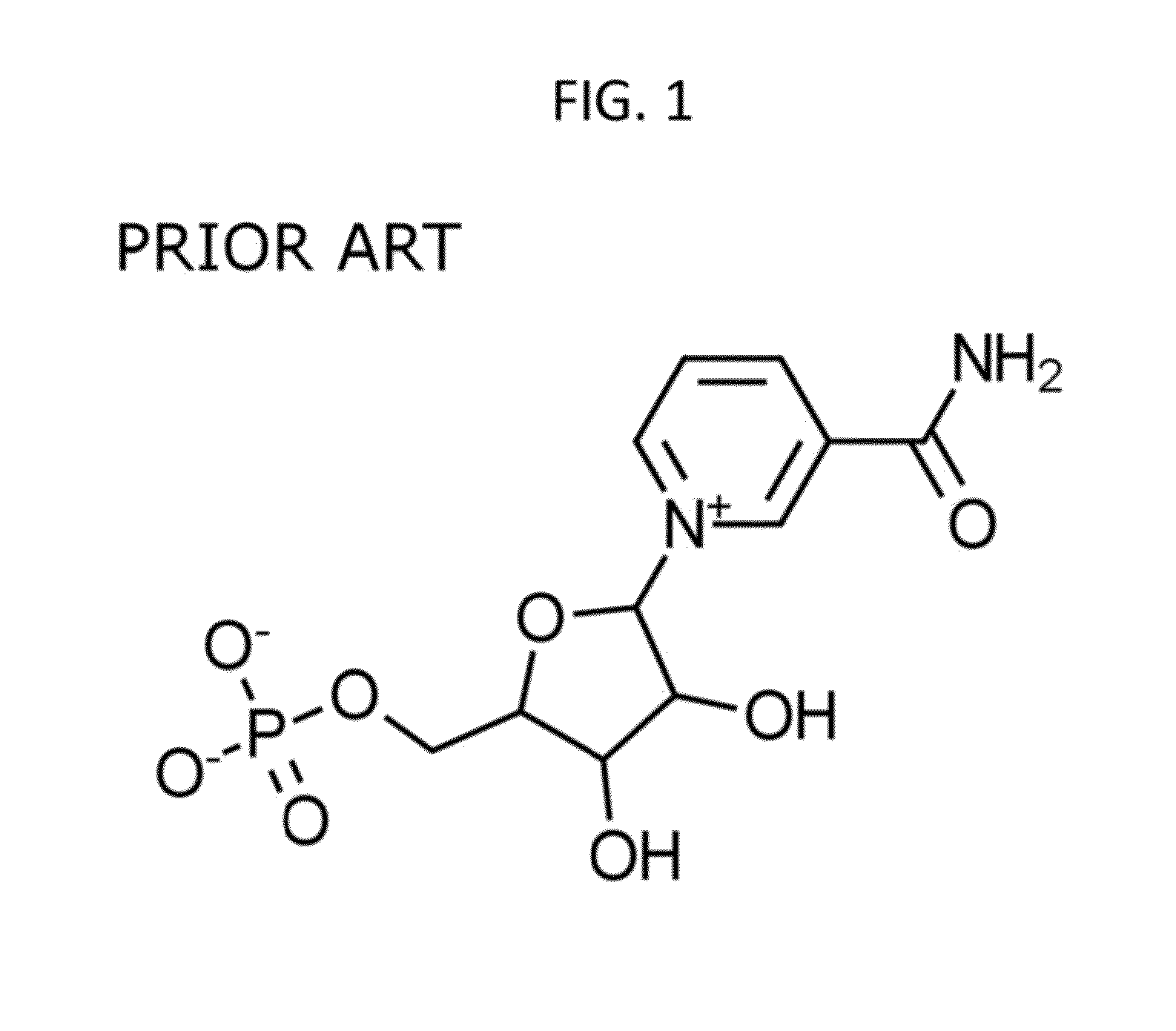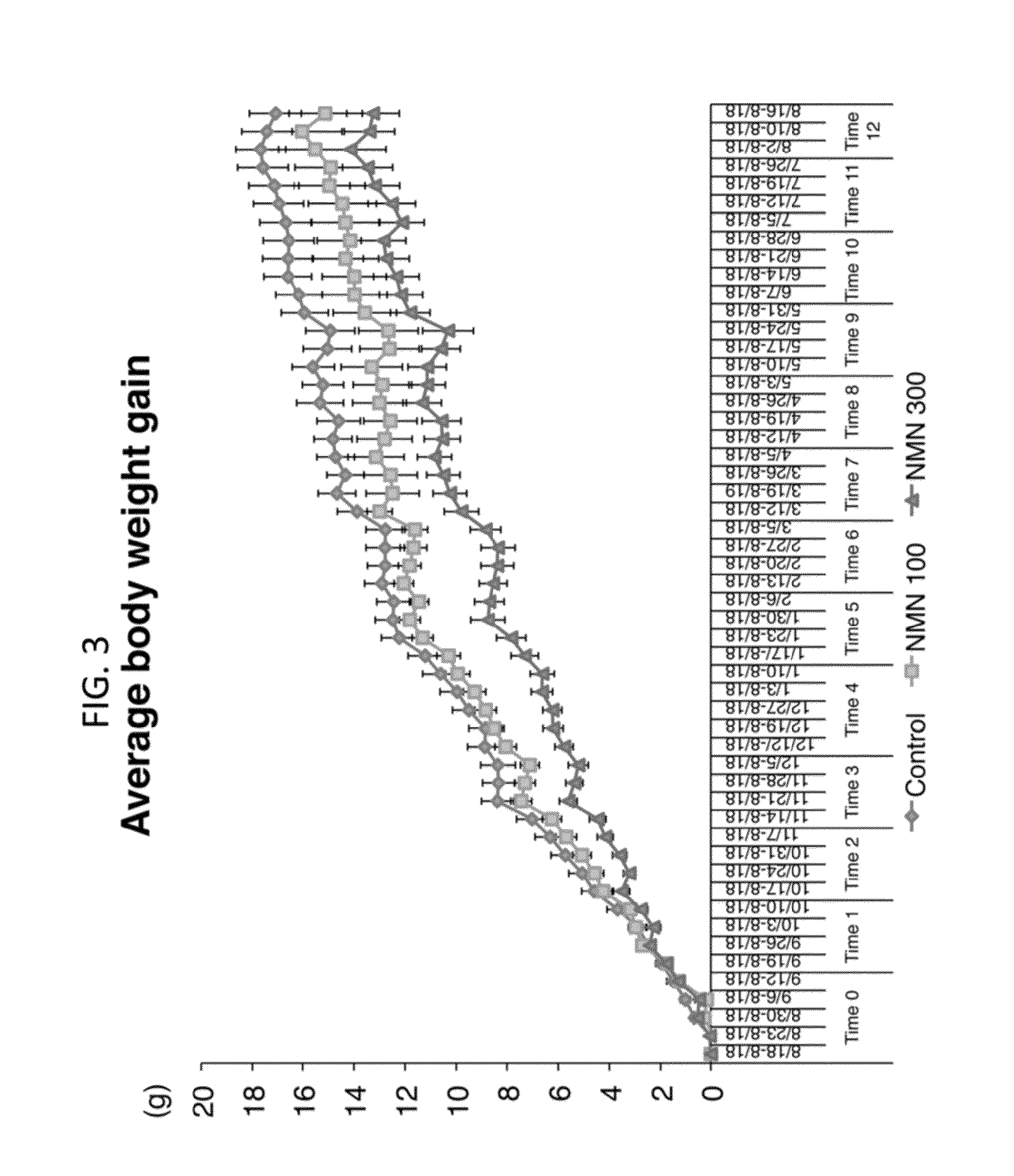Administration of Nicotinamide Mononucleotide in the Treatment of Disease
- Summary
- Abstract
- Description
- Claims
- Application Information
AI Technical Summary
Benefits of technology
Problems solved by technology
Method used
Image
Examples
example 1
[0135]This example illustrates a suppressive effect of NMN on age-associated body weight increase.
[0136]In these experiments, NMN was administered to mice at a dosage rate of 100 mg / kg per day or 300 mg / kg per day. NMN demonstrated a suppressive effect on age-associated body weight increase in a 12 month-long NMN administration study. (See Methods: Administration of NMN through Drinking Water and Determination of NMN Stability and Toxicity) In these experiments, NMN demonstrated a suppressive effect on age-associated body weight increase (FIG. 2). The results were analyzed with two-way RANOVA and one-way RANOVA with the unweighted linear term. All values are presented as mean±SEM (n=15, 14, and 14 for control, 100, and 300 mg / kg NMN-administered groups).
[0137]Average body weights in each group are shown through 0-12 months. There was a statistically highly significant interaction between time and group (P<0.001 from the two-way RANOVA), and linear dose-dependent effects were statist...
example 2
[0140]This example illustrates an enhancement of energy metabolism over age with NMN administration.
[0141]In this long-term NMN administration study (See Methods; Administration of NMN through Drinking Water and Determination of NMN Stability and Toxicity), the inventors measured oxygen consumption, energy expenditure, and respiratory quotient for control, mice administered 100 mg / kg NMN per day and mice administered 300 mg / kg NMN per day at the 12 month time point by using the Oxymax Lab Animal Monitoring System (Columbus Instruments, Columbus, Ohio).
[0142]FIG. 4 shows oxygen consumption in control, 100 and 300 mg / kg NMN-administered mice. The data were analyzed by Witcoxon signed ranks test. All values are presented as mean±SEM (n=5 in each group). ***P<0.001. As illustrated in FIG. 4, oxygen consumption significantly increased in both 100 mg / kg and 300 mg / kg groups when examined at times 0 through 27 (P<0.001, Wilcoxon signed ranks test).
[0143]Energy expenditure measurements also...
example 3
[0145]This example illustrates a suppressive effect of NMN on age-associated increases in blood lipid levels.
[0146]Blood levels of cholesterol, triglycerides, and free fatty acids are shown over 12 months in the control and the 100 and 300 mg / kg NMN-administered cohorts in FIG. 7A-C. The results were analyzed with two-way RANOVA and one-way RANOVA. All values are presented as mean±SEM (n=25 for each group).
Blood levels of cholesterol, triglycerides, and free fatty acids are shown over 12 months in the control and the 100 and 300 mg / kg NMN-administered cohorts. The results were analyzed with two-way RANOVA and one-way RANOVA. All values are presented as mean±SEM (n=25 for each group).
[0147]In the control cohort of a long-term NMN study (See Methods; Administration of NMN through Drinking Water and Determination of NMN Stability and Toxicity), blood levels of cholesterol showed steady increases over time, whereas blood levels of triglycerides and free fatty acids (FFAs) peaked at the ...
PUM
| Property | Measurement | Unit |
|---|---|---|
| Mass | aaaaa | aaaaa |
| Mass | aaaaa | aaaaa |
| Mass | aaaaa | aaaaa |
Abstract
Description
Claims
Application Information
 Login to View More
Login to View More - R&D
- Intellectual Property
- Life Sciences
- Materials
- Tech Scout
- Unparalleled Data Quality
- Higher Quality Content
- 60% Fewer Hallucinations
Browse by: Latest US Patents, China's latest patents, Technical Efficacy Thesaurus, Application Domain, Technology Topic, Popular Technical Reports.
© 2025 PatSnap. All rights reserved.Legal|Privacy policy|Modern Slavery Act Transparency Statement|Sitemap|About US| Contact US: help@patsnap.com



